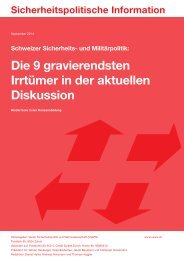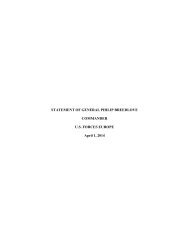FULLTEXT01
FULLTEXT01
FULLTEXT01
Create successful ePaper yourself
Turn your PDF publications into a flip-book with our unique Google optimized e-Paper software.
TACTICAL THOUGHT<br />
2014 September 29 th<br />
Appendix 8. Results from a tactical COIN doctrine study<br />
The following appendix presents results from a study delivered to the Swedish Ground<br />
Forces Combat School in 2011. A study of several questions was decided in June 2011.<br />
The study was done with the same textual analysis approach as for the literature study.<br />
The study was labelled “Tactics in COIN – On the Western front, Different news”.<br />
Results from four, of the total ten questions are presented in the following.<br />
Question 2; What characterizes the descriptions of how to analyse and understand the<br />
Insurgency movements<br />
Summary answer Canada 549 ; descriptions of how to analyse and understand Insurgency<br />
movements occur frequently through the doctrine down to company levels with<br />
characteristics described. 550 It is argued to be important to understand the causes and<br />
characteristics of the specific and general in a given situation and culture. 551 The vital<br />
importance of the intelligence function and requirements for development and adaption<br />
is underlined. 552 Six different forms of insurgency are defined to support analysis and<br />
understanding. 553 The people (in the area, as in the home country) are viewed as the<br />
strategic centre of gravity. 554 The concept of centre of gravity is used (according to the<br />
NATO view) and described in several places. 555 These centres of gravity are said to be<br />
complex at lower levels. 556 The descriptions do not include references to systems<br />
thinking.<br />
Summary answer Britain 557 ; the section "Fundamentals" highlights the importance of<br />
intelligence 558 . Intelligence is said to depend as much on the tactical level pattern of life<br />
in each area of operation as it does on the top-down feed of intelligence from<br />
operational and strategic levels. 559 Also, it is emphasized that the intelligence, including<br />
analysis, must be integrated at every level of management, as well as across and<br />
between "agencies engaged in Counterinsurgency". 560 A variety of characters of<br />
insurgencies are described that challenges the search for root causes. 561 The start for the<br />
Insurgency is viewed vital in order to correctly identify the nature of the problem that<br />
exists. 562<br />
549 National Defence Headquarters, Counterinsurgency Operations, B-GL-322-004/FP-003, Ottawa,<br />
Ontario, December 2008.<br />
550 Ibid. Chapter 2.<br />
551 Ibid. p. 45.<br />
552 Ibid. section 306, p. 73.<br />
553 Ibid. p. 50.<br />
554 Ibid. p. 48.<br />
555 Ibid. p. 107. section 5-11, pp. 107-108. and 115.<br />
556 Ibid. pp. 89. and 125.<br />
557 UK Ministry of Defence, British Army Field Manual, Volume 10, Part 10, Combined Arms<br />
Operations, Countering Insurgency, October 2009.<br />
558 Ibid. Chapter 1. Fundamentals.<br />
559 Ibid. Chapter 1. section 1-2.<br />
560 Ibid. Chapter 1. section 1-2.<br />
561 Ibid. Chapter 1. section 1-10.<br />
562 Ibid. Chapter 2. section 2-1.<br />
1





